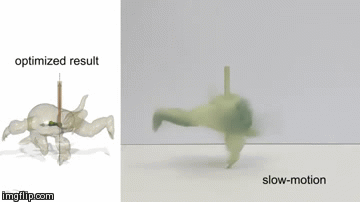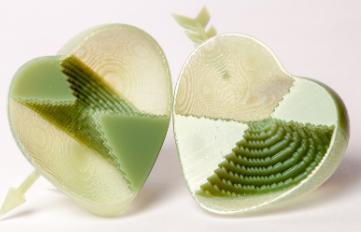When you were a kid, did you ever wish you could take your G.I Joe or Teenage Mutant Ninja Turtle action figures and spin them around on the table like you would with a top? Perhaps the Ninja Turtle, Michelangelo, had mad  breakdancing skills, and you wanted to portray this within your make-believe action figure world. Because of the uneven weight distribution of a typical action figure, it would have been impossible to spin one like you would a top. That is until now!
breakdancing skills, and you wanted to portray this within your make-believe action figure world. Because of the uneven weight distribution of a typical action figure, it would have been impossible to spin one like you would a top. That is until now!
Disney Research is at it again. Over the past several months, we have seen several unique and difficult applications within the 3D printing space which Disney Researchers have tackled. Just yesterday we reported on a new technique, developed by Disney, which allows for the scanning and 3D printing of detailed hair on figurines. Back in April, they unveiled a method which enabled the printing of a fuzzy teddy bear via a 3D felting printer, and also in April they unveiled a process of utilizing 3D printers to create electrostatic speakers in any shape desired. Clearly Disney envisions 3D printing as a major area within their business model going forward.
Yesterday Disney Research uncovered a process which allows them to take a variety of oddly shaped objects and 3D print them in a way which allows for even weight distribution, in turn allowing them to be spun like a top. Many objects printed on a 3D printer will have varying levels of infill, which is the amount of plastic inside the object. Disney has come up with algorithms within a software that allows them to take a 3D model, and  determine just how much infill should lie within certain areas, if that object was to be successfully spun on a specific axis.
determine just how much infill should lie within certain areas, if that object was to be successfully spun on a specific axis.
For instance, if an object is shaped where a bulk of the weight may be on the left side of a selected axis, the program will determine that less infill should be within the left side of that object once printed out. Not only this, but it will determine the perfect distribution of weight in terms of infill, as well as the exact placement of gaps inside the object.
“Our approach then modifies the mass distribution, such that the principal directions of the moment of inertia align with the target rotation frame,” explains the research paper. “We augment the model by creating voids inside its volume, with interior fill represented by an adaptive multi-resolution voxelization.”
Additionally, some objects are just too obscurely shaped for the software to modify its infill distribution enough for a successful spin, thus the software has the ability to modify the actual shape of the object in this case. For instance, if an action figure is too heavy on one side, and the algorithms within the software determine that it is mathematically impossible to get this particular object to spin on a given axis, it may suggest that a leg or arm is shrunk slightly. It will then modify the actual 3D model, prior to printing it out.
The researchers have also shown this approach to work with objects such as obscurely shaped yo-yos. Just how Disney my use these methods within their business is yet to be seen, however I would imagine that such techniques would be invaluable within certain mechanical fields in which weight distribution and balance remain key to a product or a component’s performance.
Let’s here your thoughts on this research in the 3D printing spinning object forum thread on 3DPBcom.

[Source: DisneyResearch.com]
Subscribe to Our Email Newsletter
Stay up-to-date on all the latest news from the 3D printing industry and receive information and offers from third party vendors.
You May Also Like
Industrial Giant Ingersoll Rand Leads $19M Round Backing Inkbit’s AI-Driven 3D Printing
Inkbit, the Massachusetts-based original equipment manufacturer (OEM) of multi-material, AI-integrated 3D printers, has closed a $19 million financing round. Ingersoll Rand, a US giant in the industrial equipment sector, led...
3D Printing Unpeeled: Digital FDM Filament for Functional Gradients
Just published in Nature, a paper by a Seoul National University team looks at “3D printing with a 3D printed digital material filament for programming functional gradients.” Sang-Joon Ahn, Howon...
3D Printing Unpeeled: $5000 Cold Spray 3D Printer, Roland DGA & Living Materials
The AeroForge is a $5000 cold spray metal printer for copper made by a student team at Rice University. In a paper for ACS Central Science a team from Nanjing...
3D Printing News Briefs, April 27, 2024: Research, Digital Dentistry, Cycling, & More
We’re starting today’s 3D Printing News Briefs with some research into 3D printed luminescent quantum-dot polymer architectures and free-form laser beam shaping, and then on to an open source 4-axis...
































